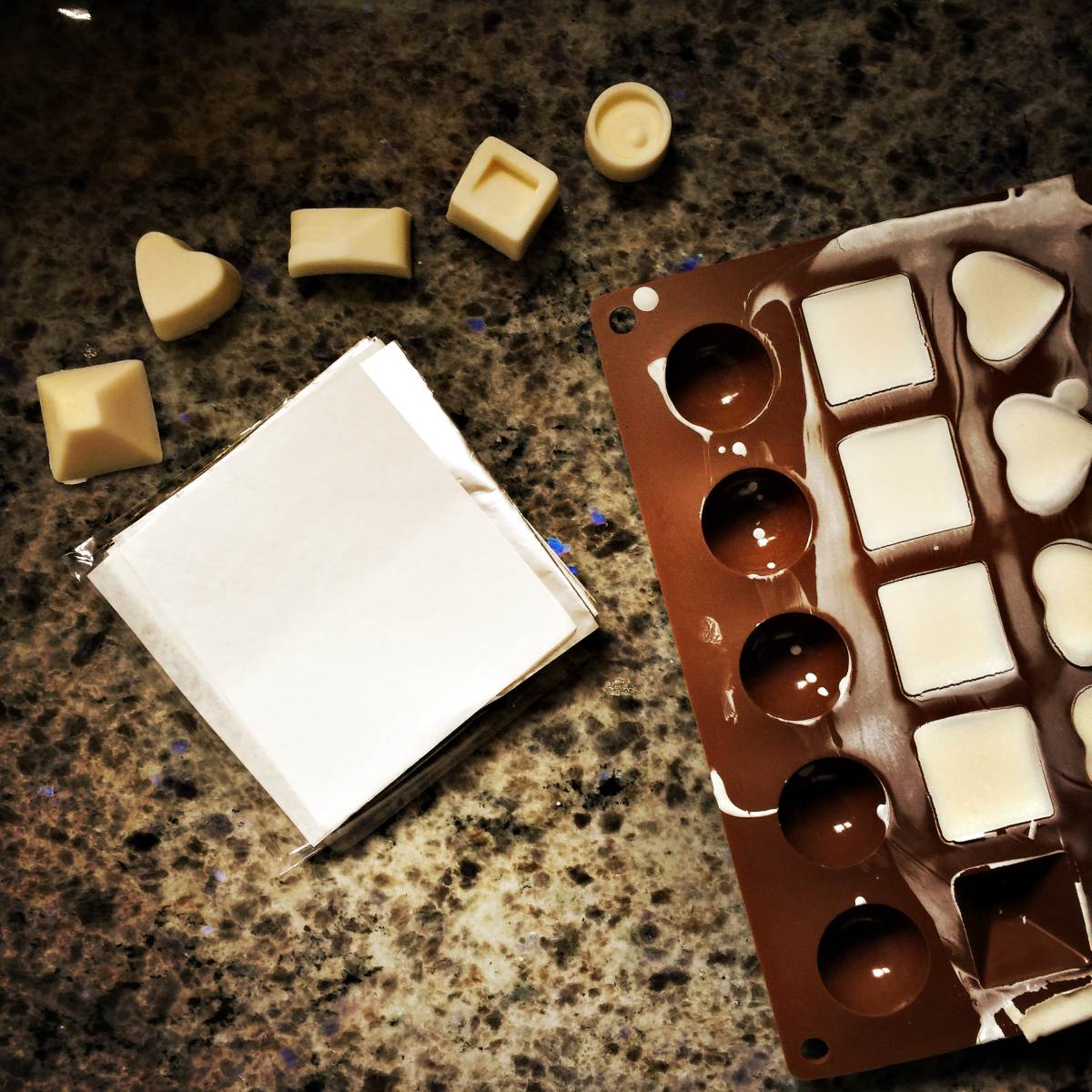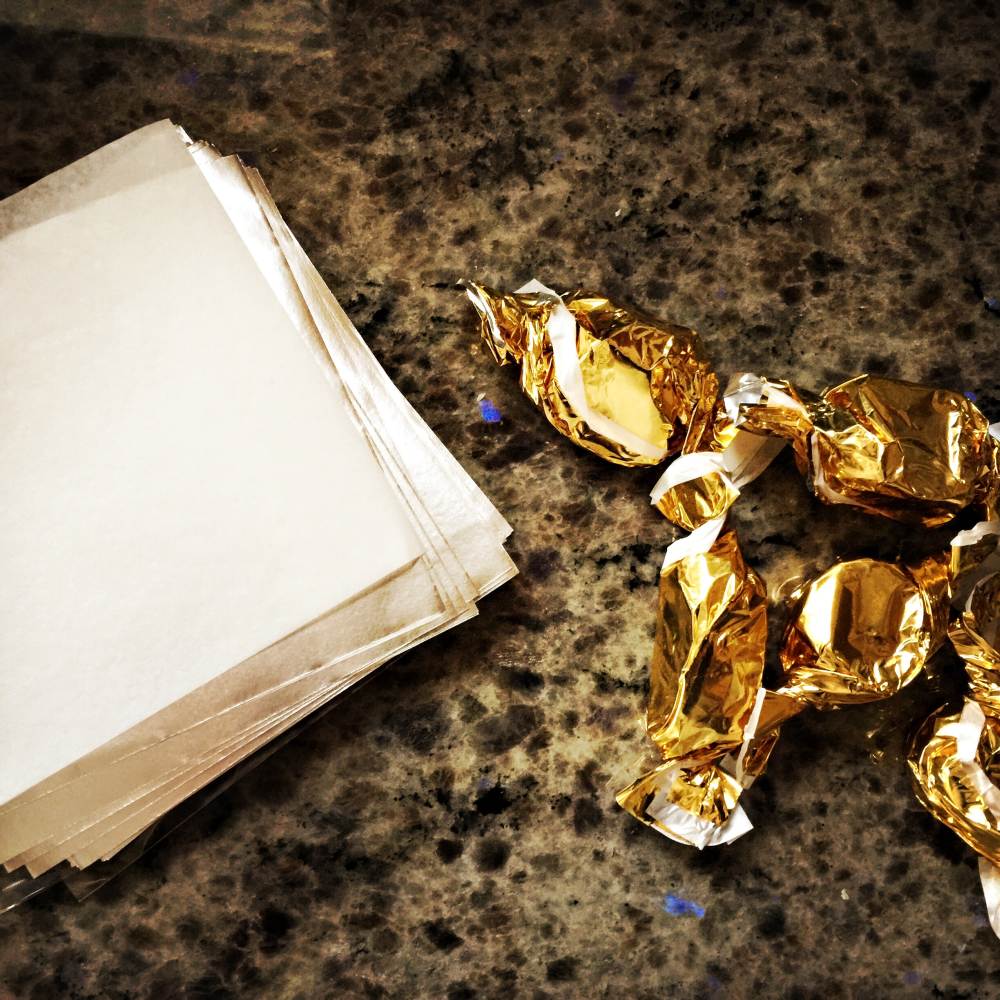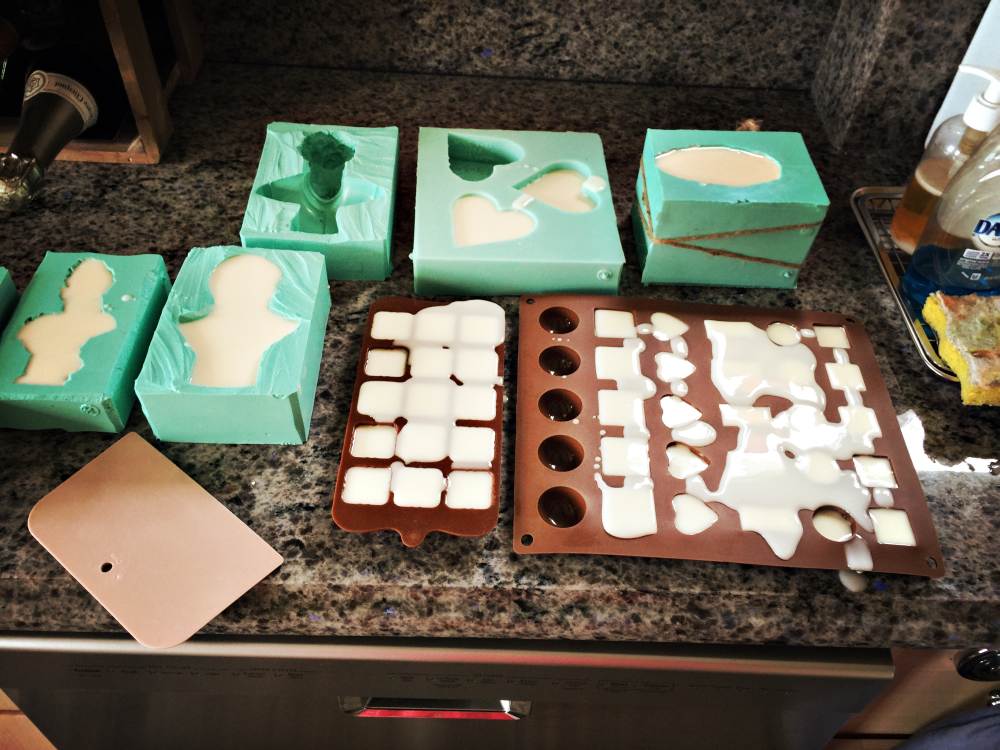We were sitting around in my kitchen, after I had just helped her make her first batch of soap. The room smelled of frankincense and we were eating pizza washed down with red wine.
I mentioned, “I need some kind of small bar mold that I can use to make travel soaps. I hate using the stuff at hotels.” And she said, “Why not make a bar like a chocolate bar? That you can just break pieces off? Wrap it in foil. Just like a chocolate bar!”
A couple days later, I was covering Hersheys bars in silicone, to make molds. (Why not? The stuff tastes like silicone anyway) And I made a batch of soap and poured it, but the result was indifferent. It turns out that some soaps, if cast thin, will curl and bend when they dry. If I put a book on it, something light like a Sam Harris book, it’d probably keep it flat but I was afraid it’d mar the surface. So I cancelled the idea.
Then I had another idea:

Soap bonbons – demold and wrap
There are a large variety of mini chocolate bonbon molds. Just make a batch of soap and pour it off into them. I used a body-filler’s spatula – basically a squeegee – to sweep the surface of the mold and get rid of any blobbies.
When the soap is cured, you demold it and wrap it up in bonbon wrappers.

Soap bonbons
If the guy from TSA says that they smell funny for chocolate, you can let them eat one, or eat one yourself, or take a shower with it. This batch is in patchouli/frankincense/ylang and they do not smell like chocolates.
I have another mold that’s a mini bundt cake mold, which makes soap bonbons that are good for a longer than usual shower or two.
Whenever I make a batch of soap I have a bunch of molds laid out on the counter so I can just fill them and – when I start to run low – I can estimate the right size of object to fill based on how much I still have left to pour.

Always keep a few other molds around to pour
Baby soap, skull soap, Marie Antoinette, Lenin.

Molds, poured and ready
By the way, I’m not averse to mailing out small care packages of weird soaps, iff’n you’re willing to give me an address to mail them to. I usually make mid-size batches, which means that at any given time I usually have a random supply of random shapes and scents. If you want to try some random soap, my contact info is on the sidebar and you can email me with an address and state any preferences you may have (which I may or may not be able to respect) I also can’t guarantee what/when I’ll get around to sending anything and besides, the Canadian post may be on strike – or, they may not!

They’re gonna strike, Marcus! They said so! Fifty times!
Shiv@#1:
There is probably a good Monty Python sketch there waiting to happen!
I thought you were going to say, “ice cube tray,” but that would be quite pedestrian compared to what you’ve produced. Very nice!
You are the crafty fellow, ain’t ya?
Marcus
You must be really, really clean.
Reading your soap adventures has made me want to try making some, couple of questions though:
I’m curious as to what oils you use as the soap base? You mentioned coconut oil and shea in one article, is that what you always use?
Have you ever made any with pomace grade olive oil?
Is making your own soap cheaper than buying it? Or is it worth it just for the fun of making it?
Normally I do a bulk buy online of 12 to 15 litres of Dr. Woods Castille liquid soap every year or so, in a mix of peppermint (perfect for spot checking that the minions actually washed their hands!) almond and black soap. Maybe when the latest batch is almost used up I’ll try making some…
GenghisFaun@3: I dunno. There are some really unusual ice trays out there, including one featuring Han Solo in carbonite.
Patrick Slattery@#6:
Different oils have different properties. At first, I thought this was BS but experience told me that it’s true. Most soap-makers come up with a blend of oils that works best for a recipe. For example, since I make stuff that I want to mold and have hold detail I need a soap that’s going to set up pretty cleanly and firmly – coconut oil and shea butter set up nice and hard and quick, and I put castor oil in also because it makes great bubbles. For most of my molds I use a recipe I devised that I call “great white” (because I was making soap sharks at the time..) that’s coconut/shea/castor For my liquid soaps I use hemp and castor and olive oil. The various properties of various oils are described here.
There’s an introductory piece I did on soap-making, which is mostly a ra-rah and link farm to other places with information I’ve found useful. It’s here
For liquid soaps there is a link to a good resource in my posting about making liquid hemp soap. Note that you will need different chemicals and processes and you’ll need bottles instead of molds.
If you’d like to try some of my hemp oil, let me know and I’ll send you some. I just made a batch and have about 5l sitting down on the shelf. One of the things cosmetics and soap makers tend to do is accumulate bottles to ship stuff around in…
Have you ever made any with pomace grade olive oil?
Yup! It’s very nice! It takes longer to harden/cure than coconut, and doesn’t make as good an impression if you’re trying to make detailed objects. It’s also good for liquid soaps.
Is making your own soap cheaper than buying it? Or is it worth it just for the fun of making it?
I do it for fun but it’s vastly cheaper. For example, a bottle of woolite is $7. And I know that it’s 95% water and about 2% detergent and 3% soap. So it’s probably 1/4 cup of soap. I make batches of 5L of soap at a shot and it costs me about $3 a batch. With the amount and concentration of the soap I make, I would never need to make soap again for the rest of my life after that first batch, except I have a lot of fun putting scents in it and shipping it to random people.
Normally I do a bulk buy online of 12 to 15 litres of Dr. Woods Castille liquid soap every year or so, in a mix of peppermint (perfect for spot checking that the minions actually washed their hands!) almond and black soap. Maybe when the latest batch is almost used up I’ll try making some…
Dr Woods is great stuff. It’s basic castille (olive oil) soap with peppermint, cut way down with a lot of water. I can make about a gallon of the stuff for a buck or two.
Email me if you want and I’ll take some of my concentrated soap and put some peppermint oil in it for you!
Note: several other FtB bloggers have experience to some degree or another with my various soaps. I don’t want to milk anyone for a testimonial but you’ll notice there haven’t been any lawsuits about anyone catching on fire or anything. ;)
Raucous Indignation@#4:
You are the crafty fellow, ain’t ya?
Yep. Next up, I am going to knit myself some global domination!
Great info there, I’ll email you and send you my mailing address. It will be way easier to persuade the wife to let me try some “chemistry experiments” in her kitchen if I can show her what it might turn out like _before_ I actually make any…
Is soap really that cheap to make? Looking at the prices of bulk oils on Amazon it seems that the oils and lye alone cost a lot more than $3 for a batch.
Coconut Oil 76 Degree 1 Gallon
https://www.amazon.com/Coconut-Oil-Degree-Gallon-Bottle/dp/B00LT11GHU
$15.69 + $12.03 shipping
2 lb Potassium Hydroxide – Red Hot Devil
https://www.amazon.com/Potassium-Hydroxide-Chemical-Caustic-Potash/dp/B00KCYP13A
$16.25 ($0.46 / oz) & FREE Shipping
Going by the soapguild.org calculator I’d need about 1.7lb of KOH for 7.3lbs of coconut oil (1 gallon @ 0.93 specific density). So that would work out at about $40 for a 2 gallon batch (after accounting for added water). I understand that this is pure soap so it would need to be watered down to a 25 to 35% concentration to be usable.
That’s certainly cheaper than buying Dr. Woods by a factor of two or three but I don’t see where your $3 a batch is coming out of, going on a 600 gram batch (as shown in your recipe) I make it out to be somewhere about $8 a batch.
Maybe you have a much cheaper source of oils and lye than Amazon? Or am I missing something?
Have you ever made Aleppo soap? I was just reading about it and it seems intriguing. I’m thinking that would be a great Farmers market stall item. Takes a lot of time to age it properly though it seems.
Patrick Slattery@#10:
Maybe you have a much cheaper source of oils and lye than Amazon? Or am I missing something?
I wasn’t counting the potash – for a liquid soap, I use about 500g (which is about 3 or 4 cups?) of hemp oil and that’s pretty much it. So I think of it as “12 batches from a gallon of oil” – I buy hemp oil in quarts. You can make (??) 6 or 7 batches of soap from a single cannister of potash. Also – I did some bulk oil buys of 5 gal tubs of coconut oil – so for all intents and purposes I feel like I have “infinite quantities of oil” – I may use one of them up in a couple years, at the rate I am going.
The place everyone buys from (then decants and relabels) is essential depot: http://www.essentialdepot.com/
If my estimate was off, I wasn’t trying to be cute; I was just lazy. :)
The Aleppo soap looks awesome. I bet it smells faboo, too!!! You’d probably want to add a dash of hyssop, frankincense oil or benzoin oil or … (goes to his happy place) If you’re concerned with the cost – laurel oil is not cheap.
The wikipedia page has some lovely pictures, including some nice cold-molded bars. If you decide to go that route and want to make some molds, I can tell you how to proceed. It’s a matter of some time with a 3D printer or CNC machine and then some siliconeing. So fun!
Wow, the bulk prices at essentialdepot.com are definitly way cheaper than any I could find on Amazon. $4 a batch seems very doable at their prices.
From what I can tell about the Aleppo soap it’s the laurel oil that makes it real Aleppo soap.
At $100 a Kg it’s an eye-watering price but you only need a few percent of it in with the olive oil. Leaving it sit for a year to turn gold is the kicker though. That’s a long time to wait…
It’s very sad to see its ancient home destroyed:
http://www.bbc.com/news/magazine-22541698
http://www.oliveoiltimes.com/olive-oil-basics/among-casualties-aleppo-ancient-olive-oil-soap/42868
Patrick Slattery @#12:
From what I can tell about the Aleppo soap it’s the laurel oil that makes it real Aleppo soap.
At $100 a Kg it’s an eye-watering price but you only need a few percent of it in with the olive oil.
I don’t want to sound too cynical, but I’d be surprised if there’s not colorant and other oils substituted. That happens a lot. I’ve seen some really goofy stuff in the ingredients of craft soaps – that’s one reason I make my own: I know it’s shea butter not beef tallow (they make a remarkably similar soap and tallow is cheap…)
I just went and looked in Arctander about Bay leaves. Interesting! Apparently “bay rum” is distilled over bay bush fires is the same way Islay malts are distilled over peat. I can’t smell bayleaves in there, though. In the summer it was my job as designated kid, to manage a supply of dry bay branches my dad used to grill and slightly smoke lamb cutlets over bay coals with a garlic / olive oil glaze and balsamic reduction…
Apparently some people hate bay, because it has some of the same terpenes as coriander/cilantro. Arctander recommends a bit of citral to bring down the edge of the scent and make it more flowery. He says lavender or ylang are also very nice with it.
One of the things I learned with scent oils is there are a lot of ruthless people out there. You can get jasmine absolute from 2 different vendors and will knock you down and step on your face, while the other is mild as a kiss from a kitten, because it was cut 1:100 with mineral oil. A cagy soap-maker would use olive oil and something cheaper like soybean oil, superfat the recipe, add the lye, and add a substantially reduced amount of bay oil after the soap is at trace. That way it won’t react as much with the lye and the scent will be stronger (even though there’s less bay oil than the recipe calls for) As far as the soap turning green – there are all kinds of natural additives that’ll make soap stain – if you want a nice coffee brown just add a few drops of vanillin. It doesn’t need to be vanillin from vanilla, there’s a process for extracting it from coal tar, which is “100% natural vanilla” as opposed to “100% natural from vanilla bean” anyway, that’ll give it a great rustic brown color depending on light hitting it. (if you’re ever going to work with stuff that has vanillin in it, use a different set of molds, or you will get brown spots on your soap. it’s OK they wash off)
Oh I don’t doubt that the majority of industrial soap makers (and every other kind of thing maker) today take every shortcut possible to make it cheaper while looking like the real thing.
However I guess I’d like to think that there are a few honest soap makers left that use the traditional recipe.
From my understanding though the bay trees on this side of the pond are completely unrelated to the European/Middle Eastern bay trees. They may share some similarity in the chemical makeup of their oils though.
Thank you so much for the soap! For those who have not gotten boxes of random soap, each item has its own wrapper and a string tied around it. It’s like a mini-birthday. I am claiming the baby soap and I think my husband wants Lenin; at least, he seems to be very amused by Lenin.
I did not know that bay has similarities to cilantro; they don’t smell at all the same to me. I always put bay in roughly the same category as thyme and rosemary: strong, warm, almost resinous, goes wonderfully with savory but well with sweet too. Cilantro is a colder flavor, like mints or dill. I once bought a set of flavoring extracts from Penzey’s and got enough bay leaves to last me a while – they pack their gift boxes with bay, cinnamon sticks and nutmegs.
ledasmom@#15:
I did not know that bay has similarities to cilantro; they don’t smell at all the same to me.
I don’t mean that they smell the same; I was referring to an apparent genetic connection to interpreting cilantro as smelling like soap, rather than minty.
http://www.nytimes.com/2010/04/14/dining/14curious.html
From what Arctander says it seems like there may be a similar predisposition for bay; it could be a genetic link to a scent receptor.
I know someone who hates cilantro. Now I need to ask them what they think of bay leaves. Sample size = 1!
Enjoy the soap! :D